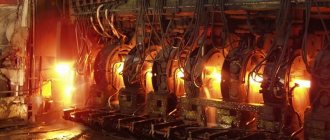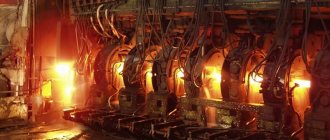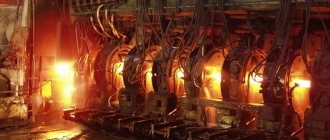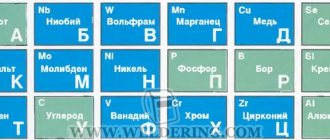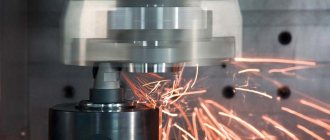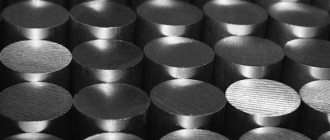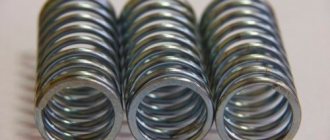We will advise you on any questions!
Have a question?
Our services
Any specialist who deals with metal is familiar with the concept of “steel grade”. Deciphering the markings of steel alloys makes it possible to get an idea of their chemical composition and physical characteristics. Understanding this marking, despite its apparent complexity, is quite simple - it is only important to know on what principle it is compiled.
Rarely does production operate without steel, so understanding its grades is extremely important
The alloy is designated by letters and numbers, which can be used to accurately determine which chemical elements it contains and in what quantity. Knowing this, as well as how each of these elements can affect the finished alloy, it is possible to determine with a high degree of probability exactly what technical characteristics are characteristic of a particular grade of steel.
Chemical composition
The main additives for alloying are metals. The variability of the quantitative composition and mass fraction makes it possible to obtain different grades. It’s just that iron, in its technical properties, is a low quality final product: low strength and high corrosion require the addition of components that will improve the quality. However, in practice it has been proven that by increasing one property, others decrease. Thus, high-alloy stainless steel has low mechanical strength, and high-quality carbon steels, while gaining strength, become corrosive.
The main components of the chemical composition of steel are carbon and iron, and carbon should be no more than 2.14%, iron no less than 50%. The amount of carbon in the composition determines its classification: low-carbon, medium-carbon, high-carbon.
If the percentage of carbon content is high enough, then the alloy is obtained with high hardness, but the strength is reduced.
To achieve the desired performance properties, chemical alloying elements are introduced, which divide the steel into three classes:
- with a low content of alloying components (up to 2.5%);
- medium alloyed – up to 10%;
- highly alloyed – up to 50%.
This is indicated in the labeling by the percentage number for each element. If there is no number, it means there are less than 1.5% additives. Carbon indicators are not displayed, since it is present in all compositions. Carbon content is at the beginning of the labeling. The same marking indicates the purpose of the alloy. There are also letters that are arranged in a certain order: beginning, middle, end.
Types of steels and features of their markings
Steel is an alloy of iron and carbon, the content of which is no more than 2.14%. Carbon gives the alloy hardness, but if it is in excess, the metal becomes too brittle.
One of the most important parameters by which steels are divided into different classes is the chemical composition. Among the steels according to this criterion, alloyed and carbon steels are distinguished, the latter are divided into low-carbon (carbon up to 0.25%), medium-carbon (0.25–0.6%) and high-carbon (they contain more than 0.6% carbon).
Types of steels
By including alloying elements in the steel, it can be given the required characteristics. It is in this way that, by combining the type and quantitative content of additives, grades with improved mechanical properties, corrosion resistance, magnetic and electrical characteristics are obtained. Of course, it is possible to improve the characteristics of steels using heat treatment, but alloying additives make it possible to do this more efficiently.
Based on the quantitative composition of alloying elements, low-, medium- and high-alloy alloys are distinguished. In the first alloying elements there is no more than 2.5%, in medium alloyed elements - 2.5–10%, in highly alloyed ones - more than 10%.
Steels are classified according to their purpose. Thus, there are instrumental and structural types, grades distinguished by special physical properties. Tool types are used for the production of stamping, measuring, and cutting tools, structural ones - for the production of products used in construction and mechanical engineering. Alloys with special physical properties (also called precision) are used to make products that must have special characteristics (magnetic, strength, etc.).
Classification of steels by purpose
Steels are also contrasted with each other based on their special chemical properties. Alloys of this group include stainless, scale-resistant, heat-resistant, etc. Typically, stainless steels can be corrosion-resistant and stainless steel for food - these are different categories.
In addition to useful elements, steel also contains harmful impurities, the main ones of which are sulfur and phosphorus. It also contains gases in an unbound state (oxygen and nitrogen), which negatively affects its characteristics.
If we consider the main harmful impurities, phosphorus increases the brittleness of the alloy, which is especially pronounced at low temperatures (the so-called cold brittleness), and sulfur causes cracks in metal heated to high temperatures (red brittleness). Phosphorus, among other things, significantly reduces the ductility of heated metal. Based on the quantitative content of these two elements, steels are divided into ordinary quality (no more than 0.06–0.07% sulfur and phosphorus), high-quality (up to 0.035%), high-quality (up to 0.025%) and especially high-quality (sulfur - up to 0.015%, phosphorus - up to 0.02%).
The marking of steels also indicates to what extent oxygen has been removed from their composition. According to the level of deoxidation, steels are divided into:
- calm type, designated by the letter combination “SP”;
- semi-calm - “PS”;
- boiling - “KP”.
Decoding of steel markings for all types and grades. We explain quickly and simply.
Despite the fact that there are no general classification rules yet, the designation of steel products has not changed and the principle remains the same. Any type of material is labeled sequentially, indicating its constituent elements and their percentage.
When notated, the transcript format is as follows:
The letter designations have 11 groups, each of which corresponds to its own material:
- C – silicon.
- G – manganese.
- N – nickel.
- M – molybdenum.
- P – phosphorus.
- X – chrome.
- K – cobalt.
- T – titanium.
- Yu – aluminum.
- D – copper.
- B – tungsten.
- F – vanadium.
- R – boron.
- A – nitrogen.
- N-niobium.
- C – zirconium.
This example looks much simpler. Let's say we have steel - 12Х18Н10Т. Explanation of the marking means that:
- This steel sample contains 0.12% carbon.
- Also used in production: 18% Chrome.
- 10% Niobium.
- Less than 1.5% of titanium was used.
Additional designations for physical properties
In addition to the previously indicated decoding order, there is also an additional classification indicating the physical and mechanical properties of steel products. They are used everywhere, characterizing certain properties of a material, for example, when a product of the same brand requires choosing one that is more elastic or can withstand much greater loads.
| Designation | Application | Unit |
| Indicated in cases where it is necessary to specify the limiting values of the workpiece during tension | MPa | |
| When is it necessary to show elasticity limits? | MPa | |
| The same parameter, but in terms of fluidity | MPa | |
| The relative elongation of steel after its rupture is indicated. | % | |
| Constriction indicator | % | |
| KCU and KCV | Impact viscosity indicators. | J/s^2 |
| The limit value of compressive yield of steel is indicated | MPa | |
| Same values when compressed | MPa | |
| Settlement index until the first cracks appear | % | |
| Torsional strength limits | MPa | |
| Shift indicators | % | |
| Permissible strength limits when bending the workpiece | MPa | |
| Permissible loads and bending endurance limits | MPa | |
| The same indicator, but only for torsion | MPa | |
| n | Loading cycles | |
| Limit creep rate for the allotted time and at a given temperature | % | |
| Shows how durable the strength characteristics of steel are | MPa | |
| HRСе | Rockwell hardness of the product | Designation scale C |
| HRB | Hardness B scale | IN |
| HB | Brinell hardness | |
| H.V. | Vickers hardness | |
| HSD | Shore hardness | |
| Indicator of possible processing and further cutting with special cutters | ||
| E | Modular elasticity value of the product | GPa |
| G | Same value, but for torsional shear | GPa |
| Density | kg/m^3 | |
| Thermal conductivity indicators | W/m(degrees Celsius) | |
| Material resistivity values | Ohm*M | |
| WITH | Specific heat | J (kg*degrees Celsius) |
Next we will look at specific examples of steel production and marking. To do this, we will select the most popular samples in our country from various groups of materials and try to explain them with examples.
What does the steel marking mean?
It has become quite easy to decipher the brand; you just need to have certain information. Structural steels of ordinary quality and not containing alloying elements are marked with the letter combination “St”. By the number following the letters in the name of the brand, you can determine how much carbon is in such an alloy (calculated in tenths of a percent). The numbers may be followed by the letters “KP”: from them it becomes clear that this alloy has not completely gone through the deoxidation process in the furnace, and accordingly, it belongs to the boiling category. If the brand name does not contain such letters, then the steel corresponds to the calm category.
Chemical composition of carbon structural steels of ordinary quality
Structural unalloyed steel, which belongs to the quality category, has two numbers in its designation; they are used to determine the average carbon content in it (calculated in hundredths of a percent).
Before we begin to consider the grades of those steels that include alloying additives, you should understand how these additives are designated. Marking of alloy steels may include the following letter designations:
List of alloying additives used
Designation of steels with alloying elements
As mentioned above, the classification of steels with alloying elements includes several categories. The marking of alloy steels is compiled according to certain rules, knowledge of which allows one to quite simply determine the category of a particular alloy and the main area of its application. In the initial part of the names of such brands there are numbers (two or one) indicating the carbon content. Two numbers indicate its average content in the alloy in hundredths of a percent, and one – in tenths. There are also steels that do not have numbers at the beginning of the brand name. This means that the carbon content in these alloys is within 1%.
Example of alloy steel marking
The letters that can be seen behind the first digits of the brand name indicate what the alloy is made of. The letters that give information about a particular element in its composition may or may not be followed by numbers. If there is a number, then it determines (in whole percentages) the average content of the element indicated by the letter in the alloy, and if there is no number, it means that this element is contained in the range from 1 to 1.5%.
At the end of the marking of certain types of steel there may be the letter “A”. This suggests that this is high quality steel. These grades may include carbon steels and alloys with alloying additives in their composition. According to the classification, this category of steels includes those in which sulfur and phosphorus amount to no more than 0.03%.
Steel classification.
Despite the existence of many modern high-tech materials, steel remains one of the most widely used materials. This also applies to the production of drive mechanisms. Whatever the gearbox, it must contain steel parts. This statement is also true for drive chains.
So, let's look at the main options for steel classification.
By appointment.
According to its purpose, steel is divided into the following categories - construction, engineering and tool.
Construction steel.
The main requirement for construction steel is good weldability. This is possible with carbon contents up to 0.25%. It would be fair to say that low-carbon steels are classified as construction steels. Typical brands are St1, St2 and St3.
Application of construction steel.
The chemical composition of building steel determines its use in various building structures or equipment when it is necessary to connect assembly units by welding. Some models of helical gearboxes are housed in construction steel housings.
Engineering steel.
Engineering steels include an alloy of iron and carbon with the latter content ranging from 0.3 to 0.7%. This type has worse weldability compared to construction steel, but at the same time it is better able to handle the hardening and tempering process. Typical grades are Steel 40X or Steel 45.
Application of engineering steel.
Medium-carbon engineering steels are used in the production of a wide range of parts in general engineering. As a rule, the production process involves thermal or chemical-thermal operations. An example of the products presented in the catalog is spare parts for gearboxes and drive roller chain links.
Tool steel.
The name of tool steel speaks for itself. The main requirement for any steel tool is hardness. This characteristic is achieved by achieving a carbon content in the alloy of over 0.7%. The most common brands are from U7 to U13.
Application of tool steel.
In addition to its direct purpose, tool steel is used in the production of various springs. In particular, flat springs are used in the assembly of electric motors and connecting chain locks.
By carbon content.
The percentage of carbon in the chemical composition of steel determines its relationship to one of three groups:
- low-carbon – carbon content less than 0.25%;
- medium-carbon – carbon content is from 0.3 to 0.7%;
- high-carbon – the proportion of carbon exceeds 0.7%.
Low carbon steels.
Low carbon steel can have many different designations. It all depends on the mass fraction of carbon and the presence of additional chemical elements in the alloy. Example - St 08ps, Steel 10 or 25HGL. The general designation is that the first number is no more than 25. The most characteristic feature of this category is excellent weldability
Use of low carbon steel in gearboxes.
Various stamped elements of gearbox housings are produced from low-carbon steels - various inspection hatches and covers. Steel with a carbon content of 0.2-0.25% is used in the manufacture of gear wheels for geared motors of the MTs2S type and spur gearboxes of the Ts2U type. To increase the strength characteristics of the gears, after machining they undergo carburization.
Medium carbon steel.
Medium-carbon steels have initial numbers in their markings from 30 to 50, which means hundredths of a percent of carbon content. Weldability is poor - everyone is familiar with the situation when a seam cracks. An example of medium-carbon steel grades is Steel 40X, Steel 45 or 50G2.
Application of medium carbon steel.
Until recently, medium-carbon steels were the main material for the manufacture of gear shafts and gear wheels. For example, gearboxes of the RM or RCD type were produced this way. Currently, various shafts and couplings operating under load or with increased vibration are made from this category of metal.
In high carbon steels, the actual carbon content exceeds 0.55%. The higher the carbon content of steel, the more its physical properties approach those of cast iron. The same can be said regarding strength. An example of brands is U7A, U9A or U13A. The production of high-carbon steels is considered more expensive.
Examples of marking steels of various types
Determining the grade of steel and assigning an alloy to a certain type is a task that should not cause any problems for a specialist. You don’t always have a table at hand that gives a breakdown of brand names, but the examples given below will help you figure it out.
Content of elements in common steel grades (click to enlarge)
Structural steels that do not contain alloying elements are designated by the letter combination “St”. The numbers following are the carbon content, calculated in hundredths of a percent. Low-alloy structural steels are marked somewhat differently. For example, 09G2S steel contains 0.09% carbon, and alloying additives (manganese, silicon, etc.) are contained within 2.5%. 10KhSND and 15KhSND, which are very similar in their markings, differ in different amounts of carbon, and the share of each alloying element in them is no more than 1%. That is why there are no numbers after the letters indicating each alloying element in such an alloy.
20Х, 30Х, 40Х, etc. – this is how structural alloy steels are marked; the predominant alloying element in them is chromium. The number at the beginning of such a mark is the carbon content in the alloy in question, calculated in hundredths of a percent. The letter designation of each alloying element can be followed by a number, which is used to determine its quantitative content in the alloy. If it is not there, then the specified element in the steel contains no more than 1.5%.
You can consider an example of the designation of chromium-silicon-manganese steel 30KhGSA. According to the labeling, it consists of carbon (0.3%), manganese, silicon, and chromium. It contains 0.8–1.1% of each of these elements.
Decoding steels and cast irons
For cast irons, called gray, the characteristic form of graphite is lamellar. They are marked with the letters SC, the numbers after the letter designation indicate the minimum value of the tensile strength.
Example 1: ChS20 – gray cast iron, has a tensile strength of up to 200 MPa. Gray cast iron is characterized by high casting properties. It can be easily processed by cutting and has anti-friction characteristics. Products made of gray cast iron can dampen vibrations well.
At the same time, they are not sufficiently resistant to tensile loads and do not have impact resistance.
Example 2: HF50 – high-strength cast iron with tensile strength up to 500 MPa. Possessing a structure in the form of spheroidal graphite, it has higher strength characteristics compared to gray cast iron. They have a certain plasticity and higher impact strength. Along with gray cast iron, high-strength cast iron has good casting characteristics, antifriction and damping properties.
These cast irons are used in the production of heavy parts, such as press equipment frames or rolling rolls, internal combustion engine crankshafts, etc.
Example 3: KCh35-10 – malleable cast iron, having a tensile strength of up to 350 MPa and allowing elongation of up to 10%.
Malleable cast irons, in comparison with gray ones, have greater strength and ductility. They are used for the production of thin-walled parts that experience shock and vibration loads: hubs, flanges, engine and machine crankcases, driveshaft forks, and so on.
How to decipher steel markings?
To make deciphering the designations of different types of steels easy, you should know well what they are. Certain categories of steel have special markings. They are usually designated by certain letters, which allows you to immediately understand both the purpose of the metal in question and its approximate composition. Let's look at some of these brands and understand their designation.
Properties and purpose of structural alloy steels
Structural steels specially intended for the manufacture of bearings can be recognized by the letter “Ш”; this letter is placed at the very beginning of their marking. After it in the brand name there is a letter designation of the corresponding alloying additives, as well as numbers by which the quantitative content of these additives is determined. Thus, steel grades ShKh4 and ShKh15, in addition to iron and carbon, contain chromium in amounts of 0.4 and 1.5%, respectively.
The letter “K”, which appears after the first digits in the brand name, indicating the quantitative carbon content, denotes structural non-alloy steels used for the production of vessels and steam boilers operating under high pressure (20K, 22K, etc.).
High-quality alloy steels, which have improved casting properties, can be recognized by the letter “L” at the very end of the marking (35ХМЛ, 40ХЛ, etc.).
Deciphering the grades of construction steel can cause some difficulty if you do not know the specifics of the markings. Alloys of this category are designated by the letter “C”, which is placed at the very beginning. The numbers following it indicate the minimum yield strength. These brands also use additional letter designations:
- letter T – heat-strengthened rolled products;
- letter K – steel, characterized by increased corrosion resistance;
- letter D is an alloy characterized by a high copper content (S345T, S390K, etc.).
Unalloyed steels belonging to the tool category are designated by the letter “U”; it is affixed at the beginning of their marking. The number following this letter expresses the quantitative carbon content in the alloy in question. Steels of this category can be high-quality and high-quality (they can be identified by the letter “A”, it is placed at the end of the brand name). Their marking may contain the letter “G”, which means a high content of manganese (U7, U8, U8A, U8GA, etc.).
Tool steels containing alloying elements in their composition are marked similarly to alloyed structural steels (KhVG, 9KhVG, etc.).
Composition of alloy tool steels (%)
The marking of those steels that are included in the high-speed cutting category begins with the letter “P”, followed by numbers indicating the quantitative content of tungsten. Otherwise, brands of such alloys are named according to the standard principle: letters denoting the element, and, accordingly, numbers reflecting its quantitative content. The designation of such steels does not indicate chromium, since its standard content in them is about 4%, as well as carbon, the amount of which is proportional to the vanadium content. If the amount of vanadium exceeds 2.5%, then its letter designation and quantitative content are affixed at the very end of the marking (З9, Р18, Р6М5Ф3, etc.).
The influence of some additives on the properties of steel
Unalloyed steels belonging to the electrical category are marked in a special way (they are also often called pure technical iron). The low electrical resistance of such metals is ensured due to the fact that their composition is characterized by a minimum carbon content - less than 0.04%. There are no letters in the designation of grades of such steels, only numbers: 10880, 20880, etc. The first digit indicates the classification by type of processing: hot-rolled or forged - 1, calibrated - 2. The second digit is associated with the category of the aging coefficient: 0 - non-standardized, 1 - normalized The third digit indicates the group to which this steel belongs according to the standardized characteristic taken as the main one. The value of the standardized characteristic itself is determined from the fourth and fifth digits.
The principles by which the designation of steel alloys is carried out were developed back in the Soviet period, but to this day they are successfully used not only in Russia, but also in the CIS countries. Having information about a particular grade of steel, you can not only determine its chemical composition, but also effectively select metals with the required characteristics.
Understanding this issue is important both for specialists who develop and design various metal structures, and for those who often work with various steels and manufacture parts from them for various purposes.
Steel U12, U12A carbon tool
Decoding
- According to GOST 1435-99, the letter U in the designation of the steel grade means that the steel is carbon.
- The number 12 following the letter Y indicates the average mass fraction of carbon in tenths of a percent, i.e. The average carbon content in steel 12 is about 1.2%
- The presence of the letter A at the end of the marking means that the steel is high quality, i.e. with increased requirements for the chemical composition.
Substitute
Steels U10A, U11A, U10, U11.
Foreign analogues [1]
| steel grade | Standard |
| N12 (Poland) | PN/H 85020 |
| N 12 E (Poland) | PN/H 85020 |
| S122 (Hungary) | MSZ 4354 |
| U12 (Bulgaria) | BDS 6751 |
| I 12 A (Bulgaria) | BDS 6751 (83) |
| SK2 (Japan) | JIS G4401 (83) |
| 19221 (Czech Republic/Slovakia) | CSN 419221 |
| BW1C (UK) | BS 4659 (89) |
| C120 KU (Italy) | UNI 2955-82 Part 2 |
| C 120E3U (France) | AFNOR NF NF A 35-590 (92) |
| C 120 (Spain) | UNE 36071 (75) |
Type of delivery
- Long products, including shaped steel: GOST 1435-90, GOST 2590-88, GOST 2591-88, GOST 2879-88.
- Calibrated rod GOST 1435-90, GOST 7417-75, GOST 8559-75, GOST 8560-78.
- Polished rod and silver steel GOST 1435-90, GOST 14955-77. Tape GOST 2283-79, GOST 21997-76.
- Strip GOST 4405-75, GOST 103-76.
- Forgings and forged blanks GOST 1435-90, GOST 4405-75, GOST 1133-71.
Characteristics and Application
Tool steel U12 (U12A) belongs to the group of steels with reduced hardenability. Steels of this group must be hardened in water, and tools made of this steel, as a rule, have an unhardened core. Quenching in water requires measures to be taken against severe warping, i.e. When designing a tool, sharp corners and sharp transitions of sections should be avoided [2].
Experience shows that the hardenability of steel U12 and U12A is very variable. Individual melts of the same brand can be calcined to different depths [3].
When choosing this grade of steel, you should keep in mind that the higher the hardness (for example, more carbon, lower tempering), the higher the wear resistance, but the lower the strength. Therefore, if the operation of the tool is not accompanied by shock loads, the blade edge has a sufficient cross-section - it is desirable to have a high hardness (62 HRC and above) and, therefore, high-carbon steel U12 should be used and a low tempering should be given (150-200 ° C), otherwise steels with lower carbon content are used, for example U7-U8, after tempering at 250-300 °C and ˂60 HRC [3]xxxxxxxxx.
U12 steel is used for the manufacture of tools with maximum wear resistance and the highest hardness, for example:
- incisors,
- various metal-cutting and measuring tools,
- files,
- chisels for cutting files,
- engraving tool,
- drawing boards, etc.
Cutting tools operating in conditions that do not cause heating of the cutting edge:
- hand taps,
- small-sized machine taps,
- dies for grains,
- small-sized reamers,
- needle files,
- measuring instrument of simple form: smooth gauges, staples,
- stands for cold grinding of edged and notched small sizes and without cross-sectional transitions,
- cold heading dies and small sized stamps,
- calibers of simple shape and lower accuracy classes.
Chemical composition, % (GOST 1435-99)
| steel grade | Mass fraction of element, % | ||||
| carbon | silicon | manganese | sulfur | phosphorus | |
| no more | |||||
| U12 | 1,10-1,29 | 0,17-0,33 | 0,17-0,33 | 0,028 | 0,030 |
| U12A | 1,10-1,29 | 0,17-0,33 | 0,17-0,28 | 0,018 | 0,025 |
Phase composition, % by mass
| Ferrite | Carbides | Carbide type |
| 81-83,5 | 18,5-17 | Fe3C |
Temperature of critical points, °C [2]
| Ac1 | Ac3 | Ar1 | Mn |
| 730 | 820 | 700 | 200 |
Hardening [3]
The hardening temperature of hypereutectoid steel U12A lies in the range between Ac3 and Ac1. The structure of steel in the hardened state consists of martensite and excess (secondary) carbides. The optimal hardening temperature is 790 °C.
In hardened steel, the tetragonality of martensite and internal stresses create significant brittleness, so tempering after hardening is a mandatory operation. [3]
Recommended hardening modes [4]
| Option | Temperature, °C | Cooling | Cooling down to 20°C | H.R.C. | Structure or score of martensite on scale No. 3 GOST 8233-56 | ||
| Wednesday | Temperature, °C | Excerpt | |||||
| I | 770-790 | Water | 20-40 | Up to 200-250 °C | In oil | 62-64 | 1 |
| II | 5% aqueous solution of table salt | 62-65 | |||||
| III | 5-10% aqueous alkali solution | 62 — 64 | |||||
| IV | 790 — 810 | Industrial oil 12 | Up to 20 - 40 °C | — | 62-64 | 1-3 For products with a diameter or thickness of less than 6-8 mm | |
| 40 — 50 | Sorbitol-troostite Depending on the diameter or thickness of the product | ||||||
| V | 790-810 | Melt of saltpeter, alkali | 150 — 180 | Exposure in the melt is equal to exposure during heating for quenching | On air | 62-64 | 1-3 For products with a diameter or thickness of less than 6-8 mm |
| VI | The melt temperature and duration of isothermal exposure are selected according to the diagram in Fig. 1, depending on the required hardness. Cooling to 20 °C in air | Sorbitol-troostite | |||||
NOTES:
- It is recommended to calculate the duration of exposure during heating for hardening according to the All-Russian Scientific Research Institute method [5].
- Option III is used to prevent the formation of soft spots during hardening.
- When adding 4 - 6% water to the alkali melt, option V is used for products with diameters or thicknesses up to 10-12 mm.
Cold treatment [4]
| Hardening option | Cooling temperature, °C | Purpose | Hardness increase ΔHRC |
| IV | -50 | Dimensional stabilization of high precision tools | 1-2 |
NOTE. Cold treatment should be carried out no later than 1 hour after hardening.
Recommended holiday modes [4]
| Option | Vacation appointment | Heating temperature, °C | Heating medium | H.R.C. |
| I | Relieving stress, stabilizing structure and dimensions | 140-160 | Oil, molten saltpeter, alkali | 62-64 |
| 160-180 | 61-63 | |||
| 180-200 | 60 — 62 | |||
| 200-250 | 56-61 | |||
| II | Relieving stress and reducing hardness | See note 2 | Melt saltpeter, alkali, air atmosphere furnace | — |
NOTE:
- High precision products (1-2 microns) after preliminary grinding are subjected to repeated tempering (aging).
- The tempering mode to obtain a hardness below HRC 56 is selected according to a schedule in accordance with the required hardness.
- Tempering at temperatures above 250 C ensures stabilization of product dimensions.
- For heating rates and holding time during tempering, see table. 3 Applications.
Tempering temperature of various tools made of U12 steel [3]
| Types of tools | Steel | Temperature, °C | Acceptance hardness of the working part HRC |
| Taps | U12 | 180-200 | 60-62 |
| Sweeps | U12 | 160-180 | 62-64 |
Hardness of carbon steel U12 after tempering [7]
| steel grade | Akalka mode | Hardness after quenching HRC | Hardness HRC after tempering at temperature in °C | |||||
| temperature in °C | cooling medium | 200 | 300 | 400 | 500 | 600 | ||
| U12 | 770-790 | Through water to oil | 62-64 | 61-63 | 54-58 | 48-52 | — | — |
Approximate heat treatment temperature and hardness of U10 steel in the annealed state [6]
| Annealing temperature °C | Hardness after annealing HB (no more) | Quenching temperature °C |
| 760-780 °C | 207 | 760-790 °C |
Technological process of isothermal annealing of steel U12, U12A [6]
| steel grade | First heating | Isothermal holding | Hardness HB | ||
| Temperature, °C | Exposure per hour | Temperature, °C | Exposure per hour | ||
| U12, U12A | 750-770 | 1,5-2,5 | 640-680 | 1-2 | 187-207 |
Recrystallization annealing temperature of steel [7]
| Pressure treatment followed by annealing | steel grade | Annealing temperature in °C |
| Cold drawing (calibration) of bars | U12 | 700 |
Approximate annealing modes for tool steels U12, U12A to improve machinability during cutting [7]
| Heating temperature in °C | Cooling | Indentation diameter according to Brinell in mm |
| 760-780 | With an oven at 50° per hour to a temperature of 500°C, and then in air | ≥4,2 |
NOTE. To improve the machinability of tool steels, high tempering at a temperature of 650-680 °C is also used.
Hardness [4]
| Without °Cannealing | After °C annealing | After °C hardening | |||
| dotp, mm | NV | dotp, mm | NV | Quenching temperature °C, °C, °C and cooling medium | H.R.C. |
| 3,7-3,3 | 269-341 | ≥4,2 | ≤207 | 760-780, water | ≥62 |
Mechanical properties depending on tempering temperature [8]
| tref., °C | σ0.2, MPa | σв, MPa | δ5, % | ψ, % | KSU, J/cm2 | Hardness HRCе |
| 400 | 1370 | 1570 | 9 | 24 | 20 | 52 |
| 500 | 880 | 1040 | 11 | 30 | 29 | 40 |
| 600 | 650 | 760 | 18 | 52 | 44 | 26 |
NOTE. Samples size 32x32x42 mm. Hardening from 760-790 °C.
Steel hardness depending on tempering temperature [8]
| tref., °C | Hardness HRCе |
| 160-180 | 62-64 |
| 180-220 | 59-63 |
| 200-270 | 55-61 |
| 450-500 | 37-47 |
NOTE. Samples with a cross section of 21-30 mm. Quenching from 810-830 °C in water.
Mechanical properties depending on test temperature
| tsp., °C | σ0.2, MPa | σв, MPa | δ5, % | ψ, % | KSU, J/cm2 |
| Annealing at 20 °C; hardness HB 207 [4, 9] | |||||
| 20 | 325 | 590-690 | 28 | 45-55 | 27 |
| 200 | — | 570 | 23 | 47 | 73 |
| 400 | 310 | 450 | 41 | 60 | 69 |
| 600 | 110 | 140 | 56 | 74 | 62 |
| 700 | 59 | 76 | 56 | 82 | 356 |
| 800 | 53 | 72 | 59 | 85 | 323 |
| 900 | 34 | 40 | 52 | 91 | 225 |
| 1000 | 20 | 28 | 55 | 98 | 157 |
| A sample with a diameter of 5 mm and a length of 25 mm, °C, deformed and annealed. Deformation speed 10 mm/min; °C strain rate 0.007 1/s [10] | |||||
| 700 | — | 105 | 60 | 68 | — |
| 800 | — | 100 | 52 | 96 | — |
| 900 | — | 60 | 40 | 100 | — |
| 1000 | — | 34 | 65 | 100 | — |
| 1100 | — | 18 | 74 | 100 | — |
| 1200 | — | 15 | 92 | 100 | — |
True generalized mechanical properties of annealed steel at 20 °C [4]
| Stretching | Compression | Torsion | |||
| sk, kgf/mm2 | q, % | sszh, kgf/mm2 | q, % | tk, kgf/mm2 | q, % |
| 50-60 | 100-110 | 50-60 | 150-160 | 50-60 | 85-95 |
- sk—true tensile strength
- sсж - true compression resistance
- q, % - true shift
- τk - true torsional strength
NOTE. For all types of deformation, fracture is ductile.
Technological properties [10]
- Forging temperature, °C: beginning 1100, end 750. Slow cooling in air.
- Weldability - not applicable to welded structures. Welding method - KTS.
- Cutting ability - Kv tv.alloy. = 1.0 and Kv σ.st = 0.9 in the annealed state at HB 207.
- Tendency to temper brittleness - not prone.
- Flock sensitivity - not sensitive.
Heat resistance [10]
| Temperature, °C | Time, h | Hardness HRCе |
| 150-160 | 1 | 63 |
| 200-220 | 1 | 59 |
Hardenability [9, 11]
| Heat treatment | Critical hardness HRCе | Critical diameter, mm, after hardening | |
| in water | In oil | ||
| Hardening | 61 | 10-20 | 4-6 |
| Hardening from 760 °C | 42-66 | 20 | — |
NOTE. Sandability is good.
Physical properties at 20 °C [12]
| Heat treatment | Hc, A/cm | μmax x 10-6, G/m | 4πJs, T | ρ, Ohm*mm2/m | γ, g/cm3 |
| Annealing | 6-8* | 85 | — | 1,9 | 7,81 |
| Hardening from 780-810 °C | 41-50 | 11-12,5 | 0,7-0,8 | 1,7-1,8 | — |
| Hardening from 780-810 °C, tempering at 150-200 °C | 40-32 | 14-17,5 | 0,75-0,8 | 1,75-1,85 | — |
- Hc—coercive force;
- μmax—maximum magnetic permeability;
- 4πJs—magnetic saturation;
- ρ—resistivity;
- γ—density;
*The lower limit of Hc values corresponds to the structure of granular perlite, the upper limit - to lamellar perlite.
Linear expansion coefficient α*106, K-1
| steel grade | α*106, K-1 at test temperature, °C | |||||||||
| 20-100 | 20-200 | 20-300 | 20-400 | 20-500 | 20-600 | 20-700 | 20-800 | 20-900 | 20-1000 | |
| U12, U12A | 10,5 | 11,8 | 12,6 | 13,4 | 14,1 | 14.8 | 15.3 | 15,0 | 16,3 | 16,8 |
Thermal conductivity coefficient λ W/(m*K)
| Steel grade | λ W/(m*K), at test temperature, °C | |||||||||
| 20 | 100 | 200 | 300 | 400 | 500 | 600 | 700 | 800 | 900 | |
| U12, U12A | — | 45 | 43 | 40 | 37 | 35 | 32 | 28 | 24 | 25 |
Specific heat capacity c, J/(kg*K)
| steel grade | s, J/(kg*K), at test temperature, °C | |||||||||
| 20-100 | 20-200 | 20-300 | 20-400 | 20-500 | 20-600 | 20-700 | 20-800 | 20-900 | 20-1000 | |
| U12, U12A | 469 | 503 | 519 | 536 | 553 | 720 | 611 | 712 | 703 | 699 |
Young's modulus (normal elasticity) E, GPa
| Steel grade | At test temperature, °C | |||||||||
| 20 | 100 | 200 | 300 | 400 | 500 | 600 | ||||
| U12 | 209 | 205 | 200 | 193 | 185 | 178 | 166 | |||
| U12A | 209 | 205 | 200 | 193 | 185 | 178 | 166 | |||
Modulus of elasticity in torsional shear G, GPa
| steel grade | At test temperature, °C | ||||||
| 20 | 100 | 200 | 300 | 400 | 500 | 600 | |
| U12, U12A | 82 | 80 | 78 | 75 | 72 | 69 | 63 |
Bibliography
- Shishkov M.M. Brand of steels and alloys. 2000
- Poznyak L.A. Tool steels: Directory. -M.: Metallurgy. 1977
- Gulyaev A.P. Metallurgy. 1977
- Gulyaev A.P. Tool steels. Directory. 1975
- Smolnikov E.A. How to calculate heating time during hardening. “Metal science and heat treatment of metals.” 1970 No. 12
- Kamenichny I.S. Practice of heat treatment of tools. 1952
- Filinov S.A., Firger I.V. Thermist's Handbook. 1969
- Tylkin M.A. Strength and wear resistance of metallurgical equipment parts. 1965
- Brand of steel and alloys, 3rd ed. Ed. Kryanina I.R. 1977
- Brand of steel and alloys. Ed. Sorokina V.G. 1989
- Brand of steels. - M.: CBTI, 1961.
- Brand of steel for mechanical engineering. NIIMASH. 1965
Find out more
Carbon steel grade st3sp - usually...
High-speed tool steel…
Alloyed tool steel…
Steel X12MF tool stamping...
